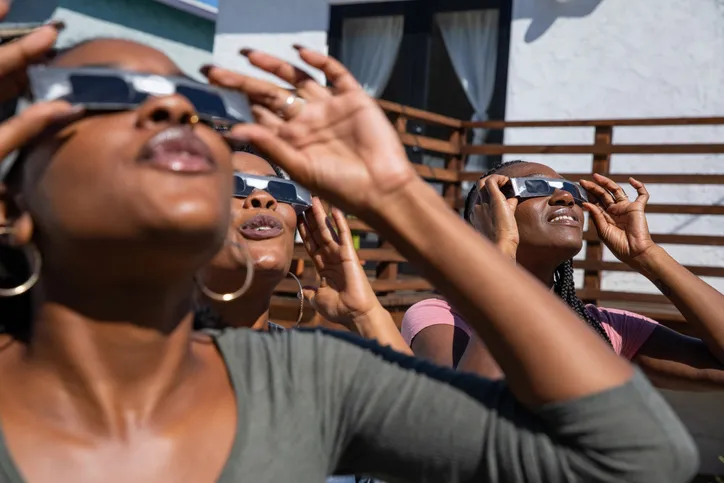Growing as a British-Indian woman, long before the Black Lives Matter movement, I sometimes felt a bit awkward about my choice to go into a career in astronomy. I was surrounded by doctors, dentists and pharmacists, and the elder generation simply didn’t understand why I might want to pursue astrophysics.
I was lucky I had a supportive family who encouraged my dreams, and I was lucky that I was resilient enough to keep going when people told me that the space industry wasn’t for me.
Today, as the Education, Outreach and Diversity officer at the Royal Astronomical Society (RAS), I hope to inspire young people from all backgrounds to pursue a career in astronomy or geophysics, regardless of ethnicity, gender, social mobility or science capital.
I work with the Committee for Diversity in Astronomy and Geophysics (CDAG) at the RAS and other organisations and groups, to study and improve diversity, or the lack thereof, in our fields, but this is no mean feat.
Even though we have been working on the issue for many years before the current Black Lives Matter protests dominated the news, we are a small organisation, and sadly, this is a huge problem.
What's being done to support BAME astronomers?
Even when focussing solely on the issues and challenges surrounding Black, Asian and Minority Ethnic (BAME) astronomers and geophysicists, there is a lot to do. Whilst there is some representation of minority ethnic scientists in our field, there are almost no Black British astronomers in the UK. The last demographic survey from the RAS in 2016 shows that 95 per cent of British respondents were white, compared with 87 per cent of the general population, and out of 903 respondents only one identified as Black and British.
What are some of the reasons for that? And what can we, the Royal Astronomical Society, do about it?
One of the defining features of space and astronomy is that it should be accessible to everyone. We are one human race, on one planet, all looking up at the same sky. However, astronomy and geophysics is overwhelmed by the ‘pale, male and stale’ category – that is, white men from the older generation.
There are very few realistic role models for Black students, and a broken pipeline for BAME young people to continue into further education and academia.

Family has a significant impact on the career choices of BAME children. Vocational careers are thought of more favourably, and a degree in physics isn’t often given the same significance as a career in medicine or accounting.
Even after I got my PhD in planetary science, I remember family members asking me what I was going to do with it, and one told me that I could use my PhD to enter into the world of finance and ‘finally get a proper job’.
An intersectional look at race in astronomy
Intersectionality – the fact that people often have several protected characteristics – should also be considered.
The gender divide adds to the issues faced by BAME students, and Black and minority ethnic girls are often presented with further barriers due to both ethnic background and gender.
A male-dominated workplace can be off-putting, and recent news items on harassment and bullying in astronomy are certainly enough to make anyone think twice about entering the field.
It is difficult to really delve into the data without losing the anonymity – the low numbers of BAME astronomers in the UK means that any data analysis could reveal identities, and without the data it isn’t always straightforward to create action plans and strategies to improve this situation.
At the RAS we don’t want to speak on behalf of the BAME community or assume what this community needs or wants, but we also don’t want to lay the burden at their feet and expect them to fix this problem. However, that doesn’t mean we are doing nothing.
Over the last few years at the RAS we have run one-off events with charities like Generating Genius and the Reach Foundation, and organisations like Black British in STEM and the Institute of Physics.
We held a nationwide screening of ‘Hidden Figures’ targeted at Black and non-white school children (mostly girls) and had over 400 students take part.
We regularly participate in Black History Month and we have presented posters showcasing Black astronomers and geophysicists in history. But we need to do more.

We created an action plan for engaging with more Black astronomers and geophysicists, and our overarching goal is to inspire more young people from BAME backgrounds to do STEM.
Action points included: a call out to our members (Fellows), for Black Fellows to get more involved in our work, including joining CDAG, an audit of our awards and grants applicants and winners, and a call for more nominations from BAME researchers, showcasing Black astronomers and geophysicists across the globe, and working with funding councils to try and fix the broken pipeline in the space industry.
Not only do we want to understand why these challenges and barriers exist, but we want to take steps to ensure that no future astronomers feel unwelcome in our field. After all, we all share the same sky and earth, no matter where we’re from or the colour of our skin.
Dr Sheila Kanani is Education, Outreach and Diversity officer at the Royal Astronomical Society. Follow her on Twitter.